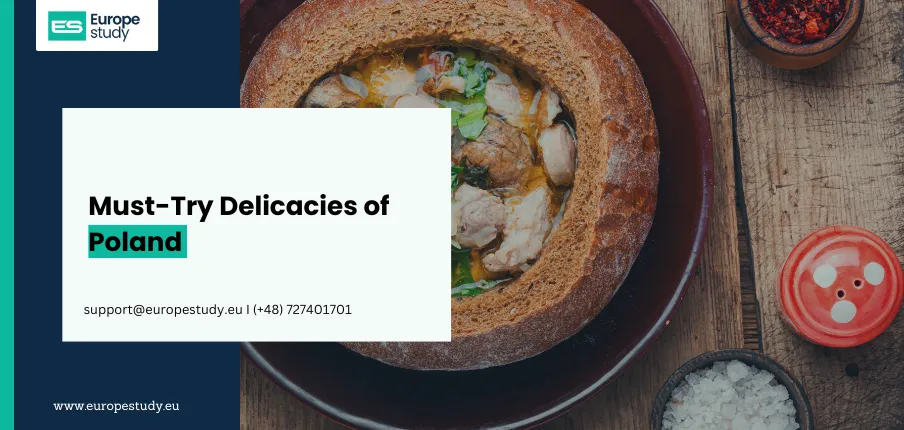
Must- Try Delicacies of Poland
Once you give it a try, you won’t be able to stop until you’ve sampled all the hearty dishes we’re about to introduce. The best part? You can find them in almost any Polish restaurant or a traditional cafeteria-style milk bar. Enjoy your meal— or as they say in Poland, smacznego!
Pierogi
Pierogi are undoubtedly one of the most popular dishes in Poland. These delicate, thinly rolled dumplings come with a variety of fillings, including meat, sauerkraut, mushrooms, potatoes, fruit preserves, and even chocolate. A similar dish, *kopytka*—named for their hoof-like shape—are potato dumplings commonly served at places like Kopytko - Jadalnia & Pijalnia and Kameralna restaurants in Warsaw.
Hearty and versatile, pierogi can be enjoyed as a snack, main course, or even dessert. They are prepared in multiple ways—boiled, baked, or fried—but in Poland, the most traditional serving style is boiled with butter and sautéed onions.
Gołąbki
If pierogi don’t catch your attention, *gołąbki* just might. This classic Polish dish features cabbage leaves wrapped around a savory filling of minced pork, garlic, onions, mushrooms, and aromatic spices. Depending on the preparation, they can be fried, steamed, or slow-cooked in fat for a rich and satisfying taste.
Though it may seem like an unexpected combination, soft cabbage leaves complement a variety of fillings, from poultry and mutton to vegetarian options. Interestingly, *gołąbki* are not unique to Poland—they are enjoyed across Central, Eastern, and Southeastern Europe, as well as in Western Asia, Northern China, and even some regions of North Africa.
Placki ziemniaczane
Placki ziemniaczane, or Polish potato pancakes, are a beloved comfort food with a crispy exterior and a soft, flavorful interior. Made from grated potatoes, eggs, flour, and a touch of seasoning, these golden pancakes are fried to perfection, resulting in a satisfying crunch. Traditionally, they are served with sour cream or applesauce, but many enjoy them with goulash, smoked salmon, or even sugar for a sweeter twist. A staple of Polish cuisine, Placki ziemniaczane can be found in restaurants, milk bars, and street food stalls across the country, offering a simple yet delicious taste of Polish culinary heritage.
Gulasz
Gulasz, the Polish take on goulash, is a rich and hearty stew that showcases tender chunks of meat—usually pork or beef—slow-cooked with onions, garlic, peppers, and a blend of aromatic spices. This comforting dish, influenced by Hungarian cuisine, is often thickened with flour or tomato paste to create a flavorful, velvety sauce. Traditionally served with potatoes, kopytka (Polish potato dumplings), or placki ziemniaczane (potato pancakes), gulasz is a favorite in Polish households, especially during the colder months. Its deep, savory flavors and warming qualities make it a staple of Polish cuisine, perfect for those who enjoy rich, slow-cooked meals.
Zurek
This distinctive yet simple soup is traditionally enjoyed during Easter and serves as Poland’s version of ryemeal soup, popular across West Slavic countries. Made from fermented rye and enriched with sausage, garlic, bacon, or ham, it boasts a rich, aromatic flavor that lingers on the palate. For an extra touch of indulgence, a boiled egg is often added, making this creamy Polish soup even more satisfying.
Kisiel
Sweet kisiel is a simple yet delicious treat, enjoyed both as a drink and a light dessert. It consists of sweetened fruit purée thickened with starch, though some variations use grain-based thickeners instead. While its unique consistency may seem unusual at first, its delightful taste is sure to impress. One of the best things about *kisiel* is its versatility—it can be made with a variety of flavors, from classic berries like strawberries and blackberries to coffee, chocolate, almond, and even vanilla.
Sernik
Now, let’s explore some delightful Polish sweets! Sernik, Poland’s beloved cheesecake, has deep roots in both Christian and Jewish culinary traditions. Made with sugar, eggs, and twaróg—a traditional Polish curd cheese that has been used for centuries—this rich dessert is a true classic. Some theories suggest that sernik was introduced in the 17th century by King Jan III Sobieski, who allegedly brought the recipe from Austria after his victory at the Battle of Vienna.
There are many variations of sernik, both baked and unbaked, but it typically features a crisp cake base. The smooth cheese filling rests on a baked crust, and some versions are topped with grated shortcrust dough before baking. Once ready, sernik is often adorned with icing, chocolate glaze, or fresh fruits, making it an irresistible treat for any occasion.
Paczki
These Polish doughnuts, known as *pączki*, are a beloved traditional dessert found in Polish bakeries and stores. These round, fluffy yeast buns come with a variety of delicious fillings, ranging from *twaróg* (Polish curd cheese) and rose or strawberry preserves to rich chocolate or even liquor. Deep-fried to a golden brown, they are typically dusted with powdered sugar, glazed, or coated in chocolate for an extra touch of sweetness.
Pączki are deeply tied to a cherished Polish tradition known as Fat Thursday (Tłusty Czwartek). On the last Thursday before Lent, people indulge in these treats without restraint, consuming an astonishing 100 million pączki each year. According to legend, skipping pączki on this day brings bad luck for the rest of the year. This belief dates back to a time when bakers would hide an almond or nut inside one pączek, and whoever found it was said to be blessed with lifelong good fortune.





